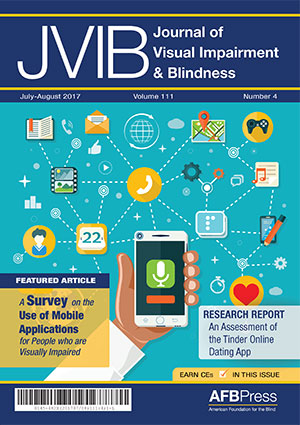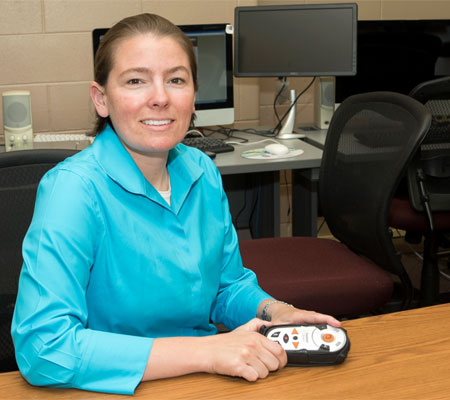 Men with visual disabilities are more likely to find dates on Tinder than are women with visual disabilities, according to a study by professors and their graduate research assistants in the NIU Department of Special and Early Education.
Men with visual disabilities are more likely to find dates on Tinder than are women with visual disabilities, according to a study by professors and their graduate research assistants in the NIU Department of Special and Early Education.
Published in the July-August issue of the Journal of Visual Impairments and Blindness, NIU’s research explores questions of whether sighted individuals are opposed to dating persons who are blind, and whether Tinder is a good vehicle to facilitate such interactions.
Researchers at NIU created eight individual Tinder profiles featuring four NIU College of Education graduate students – two men and two women, all in their early- to mid-20s – and then posted two photos of each during four separate test periods.
Half of the photos depict the students as they appear normally. In the others pictures, however, they are wearing sunglasses and holding white canes. Their clothing is the same in both photos.
Only one photo of each student was posted at any one time; “blind” and “sighted” photos were not posted simultaneously.
No written descriptions that would include personal interests, favorite things or other information were provided. Because Tinder allows users to choose a distance within which they are willing to travel for dates, NIU researchers established a radius of 50 miles from DeKalb.
When the first group of profiles were “live” on the popular dating app in the spring of 2015, the profile of the man with visual disabilities received five more “likes” than did the same man without sunglasses or cane. However, the sighted woman in that same round of testing received 14 more “likes” when she wasn’t pictured with sunglasses and cane.

During the second round, in the fall of 2015, those numbers respectively rose to nine and 58.
The percentage of “likes” for the male profiles are quite low – from 2 to 4 percent of the total 700 swipes – while the same percentages for the women range from 39 to 68 percent. Researchers attribute this to “cultural norms which dictate that men are to approach women.”
Stacy Kelly, as associate professor in the Vision Program of the NIU Department of Special and Early Education, says the study shows how sighted people view people with visual impairments as potential romantic partners.
The research also demonstrates the power of the Internet to connect people and to open personal and professional doors, she says.
“It makes you a whole person. It makes your life full,” Kelly says. “We want people who are blind to have a level playing field with their counterparts who are sighted. So much of social networking is visual in nature.”
And despite Tinder’s emphasis on photos, she says, people with visual impairments do use the app to seek romantic partners.
“They’re human,” she says, “and we know that they can be socially isolated. We know that they can struggle later in life financially, or become unemployed. And Tinder is free to use.”

Co-authors on the study are Gaylen Kapperman, professor emeritus in the NIU Vision Program; Tom Smith, an associate professor in the NIU Department of Educational Technology, Research and Assessment; and Kylie Kilmer, a graduate student in the Vision Program.
Kapperman, who is visually impaired, knows from a lifetime of conversations with others with visual impairments that they find the dating scene difficult – something that hasn’t changed following the advent of social media.
“Girls who are blind, when they have tried to initiate some kind of relationship with guys, and when they are honest in their profiles, get no takers,” Kapperman says.
One woman with visual impairments told Kapperman that she hid her blindness from a potential suitor, who discovered the truth when he came to her front door to pick her up for a date. He did not take the surprise well, the professor says, and left alone.
“I always advise people to be upfront about it,” Kapperman says.
The research project reinforces NIU’s standing as a global leader in promoting and leveraging assistive technology for people with visual impairments, she adds.
A five-year, $1.25 million U.S. Department of Education grant awarded last year to NIU will fund the preparation of students to receive the Certified Assistive Technology Instructional Specialist designation – the new national standard – from the Academy for Certification of Vision Rehabilitation and Education Professionals.
 NIU is the first university to offer a course of study toward the CATIS designation, something that leads to greater empowerment of people with visual disabilities as they are taught how to use the latest innovations.
NIU is the first university to offer a course of study toward the CATIS designation, something that leads to greater empowerment of people with visual disabilities as they are taught how to use the latest innovations.
“For people who have access to assistive technology, their whole, entire world opens up,” Kelly says. “Assistive technology gets them through the workday. It gets them through the weekend. People really can be limited if they can’t connect to the technology.”
Kelly and her cohorts plan to repeat their research to create a larger sample from which to draw data. “We see this study and the findings as just the beginning,” she says. “We are now developing a line of research that no one else has considered.”

